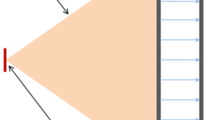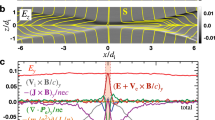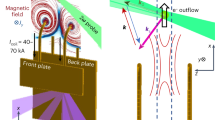Abstract
Magnetic reconnection rapidly converts magnetic energy into some combination of plasma flow energy, thermal energy and non-thermal energetic particles. Various reconnection acceleration mechanisms have been theoretically proposed and numerically studied in different collisionless and low-β environments, where β refers to the plasma-to-magnetic pressure ratio. These mechanisms include Fermi acceleration, betatron acceleration, parallel electric field acceleration along magnetic fields and direct acceleration by the reconnection electric field. However, none of them have been experimentally confirmed, as the direct observation of non-thermal particle acceleration in laboratory experiments has been difficult due to short Debye lengths for in situ measurements and short mean free paths for ex situ measurements. Here we report the direct measurement of accelerated non-thermal electrons from magnetically driven reconnection at low β in experiments using a laser-powered capacitor coil platform. We use kilojoule lasers to drive parallel currents to reconnect megagauss-level magnetic fields in a quasi-axisymmetric geometry. The angular dependence of the measured electron energy spectrum and the resulting accelerated energies, supported by particle-in-cell simulations, indicate that the mechanism of direct electric field acceleration by the out-of-plane reconnection electric field is at work. Scaled energies using this mechanism show direct relevance to astrophysical observations.
This is a preview of subscription content, access via your institution
Access options
Access Nature and 54 other Nature Portfolio journals
Get Nature+, our best-value online-access subscription
$29.99 / 30 days
cancel any time
Subscribe to this journal
Receive 12 print issues and online access
$209.00 per year
only $17.42 per issue
Buy this article
- Purchase on Springer Link
- Instant access to full article PDF
Prices may be subject to local taxes which are calculated during checkout





Similar content being viewed by others
Data availability
Data are available from the corresponding authors upon reasonable request.
Code availability
Information about the VPIC code is available via GitHub at https://github.com/lanl/vpic. Data analysis code is available from the corresponding authors upon reasonable request.
References
Yamada, M., Kulsrud, R. & Ji, H. Magnetic reconnection. Rev. Mod. Phys. 82, 603–664 (2010).
Ji, H. et al. Magnetic reconnection in the era of exascale computing and multiscale experiments. Nat. Rev. Phys. 4, 263–282 (2022).
Øieroset, M., Lin, R. P., Phan, T. D., Larson, D. E. & Bale, S. D. Evidence for electron acceleration up to ~300 keV in the magnetic reconnection diffusion region of Earth’s magnetotail. Phys. Rev. Lett. 89, 195001 (2002).
Masuda, S., Kosugi, T., Hara, H., Tsuneta, S. & Ogawara, Y. A loop-top hard X-ray source in a compact solar flare as evidence for magnetic reconnection. Nature 371, 495–497 (1994).
Krucker, S. et al. Measurements of the coronal acceleration region of a solar flare. Astrophys. J. 714, 1108–1119 (2010).
Chen, B. et al. Measurement of magnetic field and relativistic electrons along a solar flare current sheet. Nat. Astron. 4, 1140–1147 (2020).
Tavani, M. et al. Discovery of powerful gamma-ray flares from the Crab nebula. Science 331, 736–739 (2011).
Abdo, A. et al. Gamma-ray flares from the Crab nebula. Science 331, 739–742 (2011).
Kroon, J. J., Becker, P. A., Finke, J. D. & Dermer, C. D. Electron acceleration in pulsar-wind termination shocks: an application to the Crab nebula gamma-ray flares. Astrophys. J. 833, 157 (2016).
Blandford, R., Yuan, Y., Hoshino, M. & Sironi, L. Magnetoluminescence. Space Sci. Rev. 207, 291–317 (2017).
Guo, F. et al. Recent progress on particle acceleration and reconnection physics during magnetic reconnection in the magnetically-dominated relativistic regime. Phys. Plasmas 27, 080501 (2020).
Drenkhahn, G. & Spruit, H. C. Efficient acceleration and radiation in Poynting flux powered GRB outflows. Astron. Astrophys. 391, 1141–1153 (2002).
Sironi, L. & Spitkovsky, A. Relativistic reconnection: an efficient source of non-thermal particles. Astrophys. J. Lett. 783, L21 (2014).
Dahlin, J. T., Drake, J. F. & Swisdak, M. The mechanisms of electron heating and acceleration during magnetic reconnection. Phys. Plasmas 21, 092304 (2014).
Werner, G. R., Uzdensky, D. A., Cerutti, B., Nalewajko, K. & Begelman, M. C. The extent of power-law energy spectra in collisionless relativistic magnetic reconnection in pair plasmas. Astrophys. J. Lett. 816, L8 (2016).
Dahlin, J. T., Drake, J. F. & Swisdak, M. Parallel electric fields are inefficient drivers of energetic electrons in magnetic reconnection. Phys. Plasmas 23, 120704 (2016).
Totorica, S. R., Abel, T. & Fiuza, F. Nonthermal electron energization from magnetic reconnection in laser-driven plasmas. Phys. Rev. Lett. 116, 095003 (2016).
Li, X., Guo, F., Li, H. & Li, G. Particle acceleration during magnetic reconnection in a low-beta plasma. Astrophys. J. 843, 21 (2017).
Dahlin, J. T. Prospectus on electron acceleration via magnetic reconnection. Phys. Plasmas 27, 100601 (2020).
Zenitani, S. & Hoshino, M. The generation of nonthermal particles in the relativistic magnetic reconnection of pair plasmas. Astrophys. J. Lett. 562, L63–L66 (2001).
Egedal, J., Le, A. & Daughton, W. A review of pressure anisotropy caused by electron trapping in collisionless plasma, and its implications for magnetic reconnection. Phys. Plasmas 20, 061201 (2013).
Drake, J. F., Swisdak, M., Che, H. & Shay, M. A. Electron acceleration from contracting magnetic islands during reconnection. Nature 443, 553–556 (2006).
Hoshino, M., Mukai, T., Terasawa, T. & Shinohara, I. Suprathermal electron acceleration in magnetic reconnection. J. Geophys. Res. 106, 25979–25998 (2001).
Savrukhin, P. V. Generation of suprathermal electrons during magnetic reconnection at the sawtooth crash and disruption instability in the T-10 tokamak. Phys. Rev. Lett. 86, 3036–3039 (2001).
Klimanov, I., Fasoli, A. & Goodman, T. P., the TCV team. Generation of suprathermal electrons during sawtooth crashes in a tokamak plasma. Plasma Phys. Control. Fusion 49, L1–L6 (2007).
DuBois, A. M. et al. Anisotropic electron tail generation during tearing mode magnetic reconnection. Phys. Rev. Lett. 118, 075001 (2017).
Nilson, P. M. et al. Magnetic reconnection and plasma dynamics in two-beam laser-solid interactions. Phys. Rev. Lett. 97, 255001 (2006).
Willingale, L. et al. Proton deflectometry of a magnetic reconnection geometry. Phys. Plasmas 17, 043104 (2010).
Zhong, J. et al. Modelling loop-top X-ray source and reconnection outflows in solar flares with intense lasers. Nat. Phys. 6, 984–987 (2010).
Fiksel, G. et al. Magnetic reconnection between colliding magnetized laser-produced plasma plumes. Phys. Rev. Lett. 113, 105003 (2014).
E Raymond, A. et al. Relativistic-electron-driven magnetic reconnection in the laboratory. Phys. Rev. E 98, 043207 (2018).
Gao, L. et al. Ultrafast proton radiography of the magnetic fields generated by a laser-driven coil current. Phys. Plasmas 23, 043106 (2016).
Chien, A. et al. Study of a magnetically driven reconnection platform using ultrafast proton radiography. Phys. Plasmas 26, 062113 (2019).
Chien, A. et al. Pulse width dependence of magnetic field generation using laser-powered capacitor coils. Phys. Plasmas 28, 052105 (2021).
Dong, Q.-L. et al. Plasmoid ejection and secondary current sheet generation from magnetic reconnection in laser-plasma interaction. Phys. Rev. Lett. 108, 215001 (2012).
Zhong, J. Y. et al. Relativistic electrons produced by reconnecting electric field in a laser-driven bench-top solar flare. Astrophys. J. Suppl. Ser. 225, 30 (2016).
Wilks, S. C. et al. Energetic proton generation in ultra-intense laser–solid interactions. Phys. Plasmas 8, 542–549 (2001).
Yamada, M. et al. Study of driven magnetic reconnection in a laboratory plasma. Phys. Plasmas 4, 1936–1944 (1997).
Zhang, S. et al. Ion and electron acoustic bursts during anti-parallel reconnection driven by lasers. Preprint at https://arxiv.org/abs/2209.12754 (2022).
Phan, T. D. et al. Electron magnetic reconnection without ion coupling in Earth’s turbulent magnetosheath. Nature 557, 202–206 (2018).
Drake, R. P. et al. Efficient Raman sidescatter and hot-electron production in laser-plasma interaction experiments. Phys. Rev. Lett. 53, 1739–1742 (1984).
Figueroa, H., Joshi, C., Azechi, H., Ebrahim, N. A. & Estabrook, K. Stimulated Raman scattering, two-plasmon decay, and hot electron generation from underdense plasmas at 0.35 μm. Phys. Fluids 27, 1887–1896 (1984).
Ebrahim, N. A., Baldis, H. A., Joshi, C. & Benesch, R. Hot electron generation by the two-plasmon decay instability in the laser-plasma interaction at 10.6 μm. Phys. Rev. Lett. 45, 1179–1182 (1980).
Uzdensky, D. Magnetic reconnection in extreme astrophysical environments. Space Sci. Rev. 160, 45–71 (2011).
Cerutti, B., Werner, G. R., Uzdensky, D. A. & Begelman, M. C. Simulations of particle acceleration beyond the classical synchrotron burnoff limit in magnetic reconnection: an explanation of the Crab flares. Astrophys. J. 770, 147 (2013).
Bowers, K. J., Albright, B. J., Yin, L., Bergen, B. & Kwan, T. J. T. Ultrahigh performance three-dimensional electromagnetic relativistic kinetic plasma simulation. Phys. Plasmas 15, 055703 (2008).
Uzdensky, D. & Kulsrud, R. Physical origin of the quadruole out-of-plane magnetic field in Hall-magnetohydrodynamic reconnection. Phys. Plasmas 13, 062305 (2006).
Birn, J. et al. Geomagnetic Environmental Modeling (GEM) magnetic reconnection challenge. J. Geophys. Res. 106, 3715–3719 (2001).
Cassak, P., Liu, Y.-H. & Shay, M. A review of the 0.1 reconnection rate. J. Plasma Phys. 83, 715830501 (2017).
Sharma Pyakurel, P. et al. Transition from ion-coupled to electron-only reconnection: basic physics and implications for plasma turbulence. Phys. Plasmas 26, 082307 (2019).
Ji, H. & Daughton, W. Phase diagram for magnetic reconnection in heliophysical, astrophysical, and laboratory plasmas. Phys. Plasmas 18, 111207 (2011).
Hillas, A. M. The origin of ultra-high-energy cosmic rays. Annu. Rev. Astron. Astrophys. 22, 425–444 (1984).
Guo, F., Liu, Y.-H., Daughton, W. & Li, H. Particle acceleration and plasma dynamics during magnetic reconnection in the magnetically dominated regime. Astrophys. J. 806, 167 (2015).
Vilmer, N. Solar flares and energetic particles. Philos. Trans. R. Soc. A 370, 3241–3268 (2012).
Raymond, J. C., Krucker, S., Lin, R. P. & Petrosian, V. Observational aspects of particle acceleration in large solar flares. Space Sci. Rev. 173, 197–221 (2012).
Goodman, J. & Uzdensky, D. Reconnection in marginally collisionless accretion disk coronae. Astrophys. J. 688, 555–558 (2008).
Cangemi, F. et al. INTEGRAL discovery of a high-energy tail in the microquasar Cygnus X-3. Astron. Astrophys. 645, A60 (2021).
Sari, R. & Piran, T. Predictions for the very early afterglow and the optical flash. Astrophys. J. 520, 641–649 (1999).
Beloborodov, A. M. A flaring magnetar in FRB 121102? Astrophys. J. 843, L26 (2017).
Torricelli-Ciamponi, G., Pietrini, P. & Orr, A. Non-thermal emission from AGN coronae. Astron. Astrophys. 438, 55–69 (2005).
Massaro, F. & Ajello, M. Fueling lobes of radio galaxies: statistical particle acceleration and the extragalactic γ-ray background. Astrophys. J. Lett. 729, L12 (2011).
Kataoka, J., Edwards, P., Georganopoulos, M., Takahara, F. & Wagner, S. Chandra detection of hotspot and knots of 3C 303. Astron. Astrophys. 399, 91–97 (2003).
Habara, H. et al. A ten-inch manipulator (TIM) based fast-electron spectrometer with multiple viewing angles (OU-ESM). Rev. Sci. Instrum. 90, 063501 (2019).
Bonnet, T. et al. Response functions of imaging plates to photons, electrons and 4He particles. Rev. Sci. Instrum. 84, 103510 (2013).
Katz, J. et al. A reflective optical transport system for ultraviolet Thomson scattering from electron plasma waves on OMEGA. Rev. Sci. Instrum. 83, 10E349 (2012).
Li, X., Guo, F., Li, H. & Birn, J. The roles of fluid compression and shear in electron energization during magnetic reconnection. Astrophys. J. 855, 80 (2018).
Daughton, W., Scudder, J. & Karimabadi, H. Fully kinetic simulations of undriven magnetic reconnection with open boundary conditions. Phys. Plasmas 13, 072101 (2006).
Acknowledgements
This work was supported by the Department of Energy (DOE) Office of Science, Fusion Energy Sciences (FES), under the LaserNetUS initiative at the Jupiter Laser Facility and OMEGA Laser Facility. This work was mainly supported by the High Energy Density Laboratory Plasma Science program by Office of Science and NNSA under grant no. DE-SC0020103 (H.J., A.C., L.G., S.Z. and E.G.B.), and also by DOE grants GR523126 and NSF grant PHY-2020249 (E.G.B.). We express our gratitude to General Atomics, the University of Michigan and the Laboratory for Laser Energetics for target fabrication, and to the Jupiter Laser Facility, OMEGA and OMEGA EP crews for experimental and technical support. H.J. thanks M. Yamada, J.-Y. Zhong, S. Prager, C. Ren, K. Huang and Q.-M. Lu for their contributions during initial development of this project.
Author information
Authors and Affiliations
Contributions
H.J., L.G. and E.G.B. initiated the research. A.C., L.G., S.Z., H.J. and E.G.B. designed the experiments. A.C., L.G., S.Z., H.J., R.F., H.C., G.F., G.B., R.C.C., S.N.C., A.F., K.F., O.F., D.H.F., J.F., S.F., K.H., A.R. and R.T performed the experiments, with target support by S.K. and C.K. A.C. performed the PIC simulations, with major support from W.D., A.S., A.L. and F.G. A.C. performed the ray-tracing calculations. A.C., L.G., S.Z., H.J. and E.G.B. contributed to the experimental data analysis, as well as interpretation and physics discussions of the simulation results. H.J. and E.G.B. contributed to the astrophysical implications. A.C., L.G., S.Z., H.J. and E.G.B. wrote and revised the main paper. All the authors read and approved the final manuscript.
Corresponding authors
Ethics declarations
Competing interests
The authors declare no completing interests.
Peer review
Peer review information
Nature Physics thanks Anabella Araudo and the other, anonymous, reviewer(s) for their contribution to the peer review of this work.
Additional information
Publisher’s note Springer Nature remains neutral with regard to jurisdictional claims in published maps and institutional affiliations.
Extended data
Extended Data Fig. 1 Positron raytracing with vacuum coil magnetic fields without reconnection.
a, The number of positrons near the laser spot are plotted as a function of OU-ESM channel, coil configuration, and coil current. In all coil configurations, positrons are deflected near the laser spot only for small finite coil currents 0 < I ≲ 3kA, as larger coil currents deflect the positrons below the bottom of the back plate. Further, across all channels, left and right coil configurations consistently exhibit larger positron impacts than the double coil configuration. This exercise implies that LPI-generated electrons are unlikely to be preferentially accelerated to the OU-ESM by double coil magnetic fields, as compared to single coil magnetic fields. b, A simulated five-channel energy spectrum is generated by transforming the experimental no-coil spectrum via positron raytracing at energies of 20 − 100keV, in 10keV increments. The applied magnetic field is the two-coil configuration, with a constant coil current of I = 1kA. Across all channels, simulated spectral dips are observed at 30 − 50keV, in contrast with the experimental spectral bumps (Fig. 2a,b,c) at 40 − 70keV. c, Application of the same raytracing technique to the left-coil configuration can demonstrate the selection mechanism at low energies in Channels 4 and 5, as described in the Fig. 2e caption. In the raytracing spectrum, dips are observed at low energy in Channels 4 and 5, as the lower-energy positrons are preferentially deflected to large θ − z angle by the coil magnetic field.
Rights and permissions
Springer Nature or its licensor (e.g. a society or other partner) holds exclusive rights to this article under a publishing agreement with the author(s) or other rightsholder(s); author self-archiving of the accepted manuscript version of this article is solely governed by the terms of such publishing agreement and applicable law.
About this article
Cite this article
Chien, A., Gao, L., Zhang, S. et al. Non-thermal electron acceleration from magnetically driven reconnection in a laboratory plasma. Nat. Phys. 19, 254–262 (2023). https://doi.org/10.1038/s41567-022-01839-x
Received:
Accepted:
Published:
Issue Date:
DOI: https://doi.org/10.1038/s41567-022-01839-x
This article is cited by
-
Electron scale magnetic reconnections in laser produced plasmas
Reviews of Modern Plasma Physics (2023)
-
Laboratory Study of Collisionless Magnetic Reconnection
Space Science Reviews (2023)
-
Magnetic reconnection in the era of exascale computing and multiscale experiments
Nature Reviews Physics (2022)



